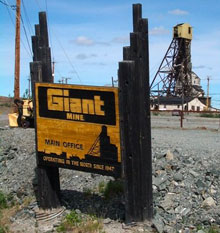Sinkhole growing at Giant Mine site in Canadian North
 Federal officials in Yellowknife, the capital of Canada’s Northwest Territories, are worried that a growing sinkhole at the former Giant Mine could result in water seeping into the site’s underground arsenic chambers.
Federal officials in Yellowknife, the capital of Canada’s Northwest Territories, are worried that a growing sinkhole at the former Giant Mine could result in water seeping into the site’s underground arsenic chambers.
The sinkhole first appeared in May and is currently six square metres in size. It’s located between Baker Creek and an open pit connected to the underground section of the mine.
The depression is close to four underground chambers in which thousands of tonnes of arsenic trioxide — a toxic byproduct of gold production — are being stored.
Officials with the federal Department of Aboriginal Affairs and Northern Development are concerned the sinkhole could make it easier for water from Baker Creek to seep into the arsenic chambers, should the creek flood again next spring.
“Water entering your mine uncontrolled is bad in any situation. We have to then treat that water so then there’s a cost associated with it,” Adrian Paradis, the acting project manager with the Giant Mine remediation team, told CBC News on Thursday.
“Having water near the arsenic chambers is something that we try to avoid,” he added. ” But it is a risk that it could eventually escape [in the] worst-case scenario.”
In addition to being toxic, arsenic trioxide is highly soluble in water. As part of their cleanup at the mine site, government officials plan to freeze 273,000 tonnes of arsenic trioxide that are being stored in underground vaults.
The federal department has filed a letter with the Mackenzie Impact Review Board this week, notifying the environmental regulator that “new activities may be required on site this year to ensure arsenic containment.”
Paradis said a plan to deal with the sinkhole should be in place by the fall. In the meantime, officials are conducting tests to ensure no water has already entered the mine site via the sinkhole, he said.
Creek winds through mine site
Giant Mine produced more than seven million ounces of gold from 1948 until it closed in 1999.
Baker Creek winds through the contaminated mine property, which is currently being cleaned up by the federal government.
In mid-May, the creek flooded its banks and spilled into one of the mine site’s waste tailings ponds and carried the contaminated water back into the creek, which flows into Great Slave Lake a few kilometres away.
The tailings areas at the Giant Mine site typically contain arsenic and other chemical byproducts of gold mining.
As a result of the flooding, arsenic levels in the creek jumped to more than 1,400 times the standard for protecting aquatic life, and 700 times the level recommended for drinking water.
Federal officials said at the time that almost none of the arsenic contained in the tailings dissolved in the water, so it could not be absorbed by fish.
At the same time, officials said the water in the creek will never be safe for drinking or swimming.
But Paradis warned that the damage from an overflow could be even worse if water seeps into the mine.
“It could overwhelm our stations and we would not be able to keep up with pumping and treating the water,” he said.
“Worst-case scenario is maximum probable floods,” he added. “we could potentially flood the mine out in three to four days.”



